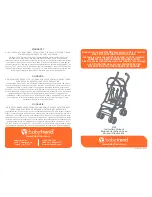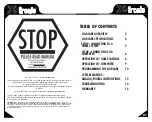
___________________________________________________________________________________________
6
EG3002
6.4
Speed GAIN, INT, and DIF Setting
6.4.1 After the engine has started and reached
operating speed adjust GAIN clockwise until
engine speed oscillates rapidly. Then adjust
GAIN counterclockwise to a point where engine
speed just becomes stable. (Go to 6.4.3)
6.4.2 If engine speed is oscillating at a rate of once
cycle every 2 to 5 seconds then slowly adjust INT
counterclockwise until speed is stable. If
adjustment to maximum does not stop the engine
speed oscillation it could be an “extreme slow
response” engine. Turn ON SW-6 (extreme slow
response engine) and repeat this step again.
6.4.3 Observe the variation in engine speed between
load and unload condition. If the rise or fall in
speed is greater than allowed then adjust DIF
clockwise. If engine speed becomes unstable
after adjustment then return DIF to its original
setting and increase INT. Repeat the steps above
until linkage oscillates 3 to 5 times in one second
and then becomes stable. This is the correct
setting.
For details on speed gain (GAIN), integral (INT),
derivative (DIF), refer to.
http://edu.kutai.com.tw/egspeed.pdf
NOTICE
1. If GAIN is set too low engine speed could
accelerate directly to over speed when started or
could oscillate slowly, with a period of 3 – 5
seconds, so should be avoided.
2. If GAIN and/or DIF are set too high engine speed
could easily be made to oscillate. Adjust GAIN
and DIF repeatedly until optimal settings are
achieved.
3. Engine speed instability can be divided into slow
oscillations (once every 2 to 5 seconds) and rapid
oscillations (2 to 8 times per second); slow
oscillation is usually because GAIN is too low
and/or INT is too high. Rapid oscillations,
however, can occur in two ways:
4. 2 – 4 times per second – GAIN setting too high.
4 – 8 times per second – DIF setting too high.
6.5
Remote Speed Pot Adjustment
The EG3002 provides two remote speed adjustment
methods. One uses a 5 K
Ω
potentiometer to provide
+ / - 7% speed adjustment remotely up to 60 meters.
The other uses an analog input voltage that provides
1.5% speed adjustment for each 1 Vdc. For connection
details see Section 5. Wiring Diagram.
NOTICE
Increasing or decreasing the resistance of the
Remote Speed Pot will not affect frequency
adjustment range.
To increase the external frequency adjustment
range, short terminals 8 & 9 together and connect
to the center tap of the remote speed pot.
To decrease the external frequency adjustment
range install resistor (R) in series with terminal 9
and the center tap of remote speed pot.
6.6
Parallel Generator Operation
When a generator is used in parallel operation the
speed DROOP is used to distribute power between
generator sets. Clockwise adjustment will increase the
rate of speed Droop. A speed Droop of 2% at maximum
load is recommended.
DROOP setting calculation is as follows
:
F1 = (1 – D) x F2
F
1
= Droop speed with load (RPM or Hz)
D = Droop rate setting x load ratio
F
2
= Operating speed (RPM or Hz)
Example: If speed Droop is 3% under full load. When
current load is 80% of generator capacity and engine
speed is 1800 RPM then Engine speed will be (1 –
0.03 x 0.8) x 1800 = 1757 RPM.


























